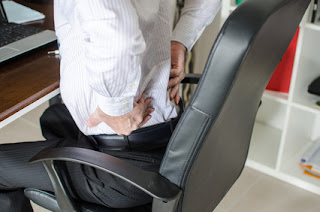-
Consider a standing desk so your legs have constant range of motion and you are able to shift your body more frequently.
-
If seated at a traditional desk chair, check that the seat height is appropriate. Feet should rest comfortably flat on the floor with knees and hips able to bend easily at 90-degree angles.
-
At least once every hour, stand up and take a quick lap around your office floor and/or do some stretching—like reaching arms high up above your head or extending them out to the sides for several counts.
-
Organize “walking” meetings with colleagues, or use a mobile headset if it’s just you on a training or conference call. Walk up and down halls, stairwells, or even parking lots and garages.
-
Try some easy exercises at your desk when you feel tension setting in, such as shoulder shrugs, neck rolls, torso twists, or seated leg extensions.
Prolonged Sitting at Work
It’s easy to stay plopped down in your desk chair at work for hours on end without so much as a twitch.
But research has shown that prolonged sitting can do a number on your body. Unfortunately, this is typical in many office settings as people are tied to their desks, sometimes hours on end.
Being sedentary for hours at a time can trigger neck, shoulder, and back pain, as well as headaches and other more serious issues like carpal tunnel syndrome, all of which can ultimately lead to decreased productivity and even missed days.
Making small adjustments in the way you sit, or maneuver yourself during the workday, can provide numerous health benefits in and out of the office.
Here are simple tips to ease your aches and pains due to prolonged sitting:
If any of your aches and pains are severe, or persist over a long period of time, please contact us for an appointment.



